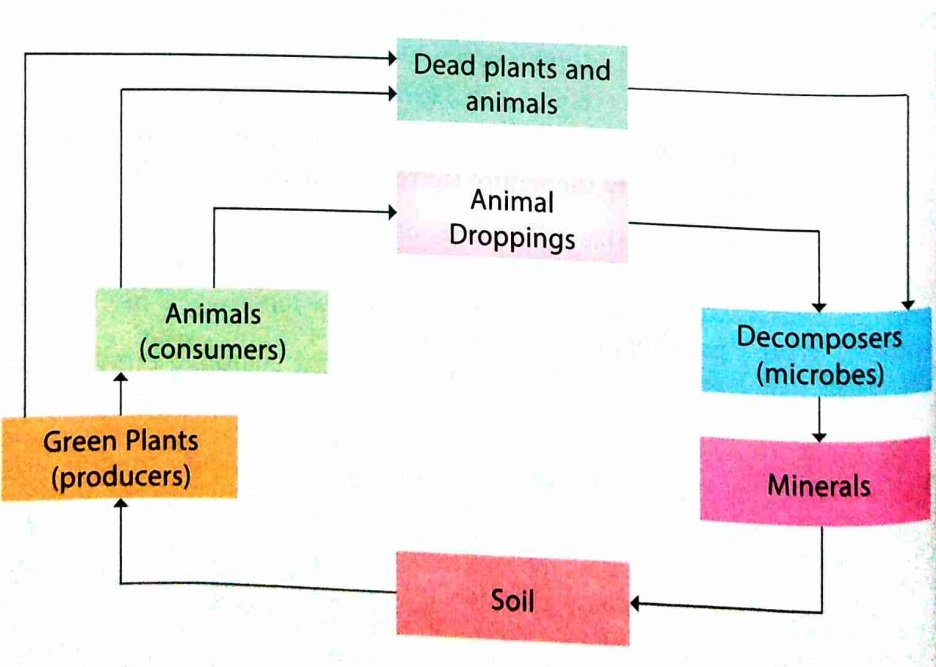You Must Know
1. Environment consists of biotic (living) components and abiotic (non-living) components.
2. Producers, or Autotrophs, prepare their own food; Consumers, or Heterotrophs, depend directly, or indirectly, upon them.
3. Primary consumers, or Herbivores, feed only on plants.
4. Secondary consumers, or Carnivores, feed on other animals.
5. Animals, which feed on both producers as well as consumers, are called Omnivores.
6. Decomposers break down dead and decaying plants and animals into minerals; these go into the soil and are used again by plants. This process is called recycling of minerals.
7. Biodegradable materials can be decomposed by micro-organisms.
8. Non-biodegradable materials cannot be decomposed by micro-organisms.
9. Vermicomposting is the process of preparing compost from kitchen garbage using redworms and other various worms.
10. The sequence, of one organism eating the other, and then getting eaten by another, and so on, makes up a food chain.
11. The cycling of materials, through biotic and abiotic components, is called the mineral cycle.
12. The balance, of carbon dioxide and oxygen, in the atmosphere, is maintained through the processes of respiration, burning and photosynthesis.
Something To Know
A. Fill in the blanks.
1. Plastic is non-biodegradable as it cannot be broken down into simpler substances in nature.
2. We must say ‘No’ to Polythene bags and use Jute bag or cloth bag.
3. The flowers of the morning glory bloom with sunrise and close after sunset.
4. Polar bear and penguin are among the animals found only in cold regions.
5. Respiration and photosynthesis processes help in balancing of carbon dioxide and oxygen in the atmosphere.
B. Write True or False for the following statements.
1. Herbivores can prepare their own food. False
2. Fungi and bacteria are organisms that can be easily seen by the human eye, by itself. False
3. The sunflower faces the east in the morning. True
4. Camels do not have sweat glands. True
5. Soil is an important biotic component of our environment. False
C. Tick (✔) the correct option.
1. Biotic environment includes-
only the producers and the consumers
only the consumers and decomposers
only the decomposers and the producers
producers, consumers as well as decomposers(✔)
Answer – producers, consumers as well as decomposers(✔)
2. The group of organisms, which use light for making food, are called-
heterotrophs
autotrophs (✔)
decomposers
scavengers
Answer – autotrophs(✔)
3. Decomposers include-
bacteria only
bacteria as well as fungi (✔)
only the scavengers
fungi only
Answer – bacteria as well as fungi(✔)
4. Which of the following is not biodegradable?
vegetables
earthworm
fruits
aluminium foil (✔)
Answer – aluminium foil (✔)
5. Vermicomposting is done by—-
fungus
worms (✔)
bacteria
aquatic animals
Answer – worms (✔)
6. An animal, that is not affected much by the heat of the desert, is the-
rat
cow
camel (✔)
lion
Answer – camel (✔)
D. Answer the following questions in brief.
1. Why should we segregate different types of wastes?
Answer – We should segregate different types of wastes, because some wastes are non- biodegradable which cannot be decomposed by microorganisms and should be disposed separately from biodegradable wastes.
2. Write the meaning of the term ‘vermicomposting.
Answer – Vermicomposting is the process of making compost by mixing the kitchen waste by a variety of earthworms.
3. Which component of air gets ‘used-up’ during the process of photosynthesis?
Answer – Carbon dioxide is used up during the process of photosynthesis.
4. Suggest any five activities that can help to save the environment.
Answer – Five activities that can help to save the environment:
Separating biodegradable and non-biodegradable wastes.
Reduce, reuse and recycle the waste materials.
Making compost out of kitchen waste.
Planting trees
Using sustainable sources of energy.
5. How does nature maintain a balance, between the amounts of oxygen and carbon dioxide, in the atmosphere?
Answer – During the process of respiration, both plants and animals take in oxygen from the atmosphere and give out carbon dioxide back into the atmosphere. The plants use up carbon dioxide and give out oxygen during the process of photosynthesis. Thus a balance is maintained, between the amount of oxygen and carbon dioxide in the atmosphere.
E. Answer the following questions.
1. Distinguish between-
(a) autotrophs and heterotrophs
Answer – (a) Autotrophs are organisms which prepare their own food (glucose) and heterotrophs are organisms which cannot prepare their own food and depend on plants for their food. Green plants are autotrophs and animals are heterotrophs.
(b) decomposers and scavengers
Answer – Decomposers are the organisms which derive their food from dead and decaying plants and animals. Examples are bacteria and fungi.
Scavengers are the animals which consume dead bodies of other animals. Examples are jackals, crows, vultures and kites.
2. State the difference between biodegradable and non-biodegradable materials. Give one example of each.
Answer – Biodegradable materials can be decomposed by microorganisms like bacteria and fungi. Whereas non-biodegradable materials cannot be decomposed by the microorganisms. Examples of biodegradable materials are vegetable peels. Examples of non-biodegradable substances are plastic.
3. How does decomposition of dead animals turn out to be useful?
Answer – Decomposition of dead animals helps in maintaining the mineral cycle in nature and cleanliness in the environment.
If there had been no decomposition, there would be piles of dead bodies of various plants and animals. This will lead to a shortage of free space.
4. Why is Rain water harvesting a ‘ray of hope’ for overcoming the present ‘scarcity of water’ in cities?
Answer – Rainwater harvesting can supplement the requirement of water in cities and raise the subsoil water level. This can help in maintaining and increasing greenery in urban cities
5. Why do buffaloes cool themselves in water during summer?
Answer – This is because buffaloes are black in colour and do not have efficient sweat glands. Hence, they feel the heat more and need to cool themselves by remaining in water.
6. Draw a diagram that shows the relationship between the biotic and the abiotic components of the environment.
Answer – Draw diagram given in page number 10.

Value Based Question
Shuchi’s mother did not approve of her idea of taking help from their neighbours for making models for her school exhibition. She told her that she should do her work herself with confidence and honesty. She then helped and guided Shuchi to design very useful, interesting and attractive items from old newspapers. Shuchi’s models were very much appreciated as they were in tune with the concepts of ‘reuse’ and ‘recycle’.
1. State the values conveyed by Shuchi’s mother.
Answer – Values conveyed by Suchi’s mother are confidence, honesty, and self-dependence.
2. Give one example of ‘recycling’ of a material.
Answer – We can make paper bags from old newspapers.
3. Have a group discussion with your friends in which each one suggests one or more ideas, in tune with the idea of ‘recycling’ or ‘reuse.
Answer – Teacher will conduct this task in the classroom.
Something To Do
1. Imagine a scenario
The government is planning to ban the use of plastic bags. For a debate over the same, a committee was formed. A meeting of the committee is being called. The members of the committee are:
A government representative
A head of shopkeepers’ association
A plastic bag manufacturer
A cloth bag manufacturer
An environmentalist
Prepare, and present, a skit projecting the likely views of the members who attended the meeting.
Answer – Government Representative: The government is committed to protect the environment. He will make every effort to stop the use of plastic bags.
Head of Shopkeeper’s Association: We also need to participate in this great effort. We will educate our customers to bring jute hags.
Plastic Bag Manufacturer: I will lose my livelihood. Government should devise sem mechanism to properly dispose plastic waste. What will happen to my family and my workers?
Cloth Bag Manufacturer: It will definitely help the environment. We will make more bags to help this cause.
An Environmentalist: Environment is more important than anyone’s livelihood. We should come forward to protect the environment at any cost.
2. The waste segregation methods, adopted by two neighbours, Ramesh and Suresh, are shown here in the form of the pie charts. Study the pie charts carefully and answer the questions that follow.
kitchen & plastic
paper waste
1. Name the two items of waste, disposed off by Ramesh, that needs to be separated from one another.
Answer – Kitchen and plastic waste.
2. Identify the biodegradable materials disposed off by Suresh.
Answer – Paper waste, kitchen waste.
3. Of the two, who, according to you, is more eco-friendly and why?
Answer – Suresh has properly segregated the waste into biodegradable and non-biodegradable. Hence, he appears to be more eco-friendly than Ramesh.
3. Solve the following crossword puzzle with the help of given clues.
Across →
a. Do not make their own food. Heterotrophs
b. Non-living components. Abiotic
c. Meat eaters. Carnivores
d. Vulture is a Scavenger
e. Compost prepared by worms. Vermicompost
Down↓
f. Plant eaters. Herbivores
g. Morning glory. Ipomoea
h. A desert animal. Camel
i. Decomposable material. Biodegradable
j. Helps in recycling of minerals. Decomposer

